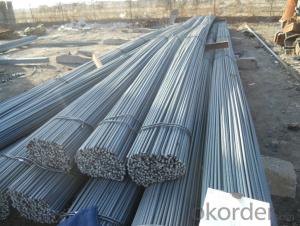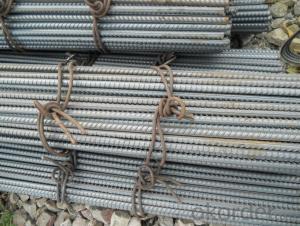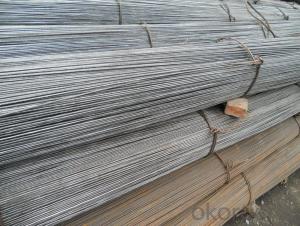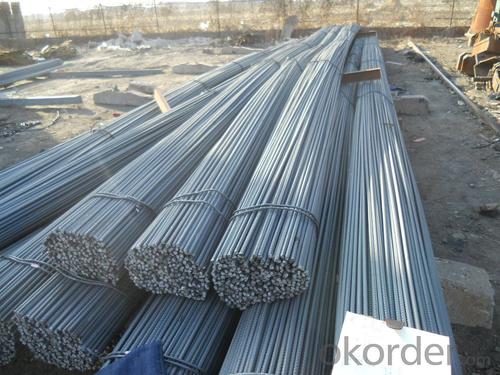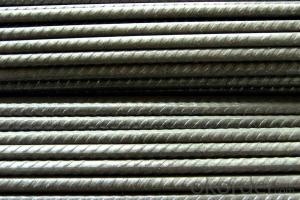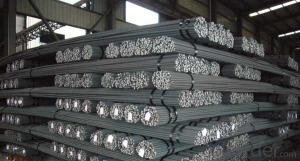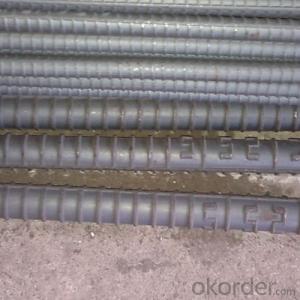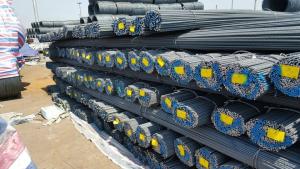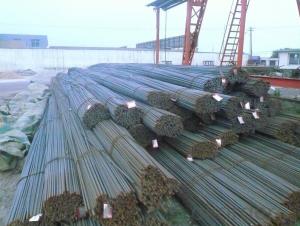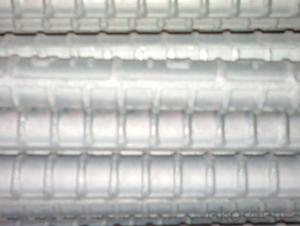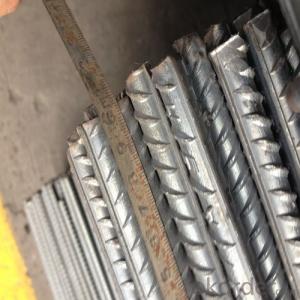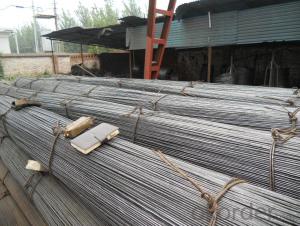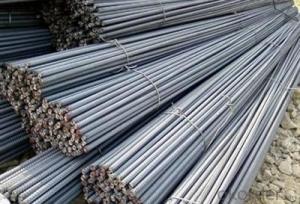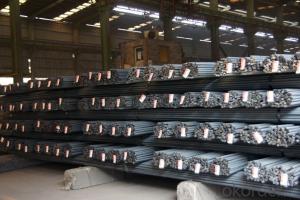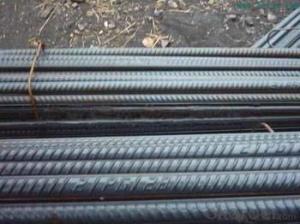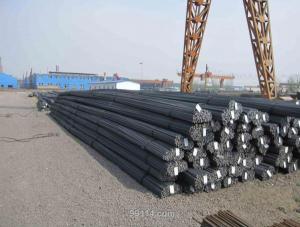deformed steelbar
- Loading Port:
- China Main Port
- Payment Terms:
- TT OR LC
- Min Order Qty:
- -
- Supply Capability:
- -
OKorder Service Pledge
OKorder Financial Service
You Might Also Like
Standard | GB | HRB400 | |
Diameter | 6mm,8mm,10mm,12mm,14mm,16mm,18mm,20mm, 22mm,25mm,28mm,32mm,36mm,40mm,50mm | | |
| | |||
Length | 6M, 9M,12M or as required | | |
Place of origin | Hebei, China mainland | | |
Advantages | exact size, regular package, chemical and mechanical properties are stable. | | |
Type | Hot rolled deformed steel bar | | |
Brand name | DRAGON | | |
Chemical Composition: (Please kindly find our chemistry of our material based on HRB500 as below for your information)
Grade | Technical data of the original chemical composition (%) | ||||||
C | Mn | Si | S | P | V | ||
HRB400 | ≤0.25 | ≤1.60 | ≤0.80 | ≤0.045 | ≤0.045 | 0.04-0.12 | |
Physical capability | |||||||
Yield Strength (N/cm²) | Tensile Strength (N/cm²) | Elongation (%) | |||||
≥400 | ≥570 | ≥14 | |||||
Theoretical weight and section area of each diameter as below for your information:
Diameter(mm) | Section area (mm²) | Mass(kg/m) | Weight of 12m bar(kg) |
6 | 28.27 | 0.222 | 2.664 |
8 | 50.27 | 0.395 | 4.74 |
10 | 78.54 | 0.617 | 7.404 |
12 | 113.1 | 0.888 | 10.656 |
14 | 153.9 | 1.21 | 14.52 |
16 | 201.1 | 1.58 | 18.96 |
18 | 254.5 | 2.00 | 24 |
20 | 314.2 | 2.47 | 29.64 |
22 | 380.1 | 2.98 | 35.76 |
25 | 490.9 | 3.85 | 46.2 |
28 | 615.8 | 4.83 | 57.96 |
32 | 804.2 | 6.31 | 75.72 |
36 | 1018 | 7.99 | 98.88 |
40 | 1257 | 9.87 | 118.44 |
50 | 1964 | 15.42 | 185.04 |
Usage and Applications of HRB400 Deformed Steel Bar:
Deformed bar is widely used in buildings, bridges, roads and other engineering construction. Big to highways, railways, bridges, culverts, tunnels, public facilities such as flood control, dam, small to housing construction, beam, column, wall and the foundation of the plate, deformed bar is an integral structure material. With the development of world economy and the vigorous development of infrastructure construction, real estate, the demand for deformed bar will be larger and larger..
Packaging & Delivery of HRB400 Deformed Steel Bar:
Packaging Detail: products are packed in bundle and then shipped by container or bulk vessel, deformed bar is usually naked strapping delivery, when storing, please pay attention to moisture proof. The performance of rust will produce adverse effect.
Each bundle weight: 2-3MT, or as required
- Q: Can steel rebars be used in retrofitting existing structures?
- Yes, steel rebars can be used in retrofitting existing structures. Retrofitting is the process of strengthening or upgrading existing buildings or structures to make them more resistant to various forces or to meet new design requirements. Steel rebars are commonly used in retrofitting as they provide increased structural strength and stability when properly installed and reinforced within existing structures.
- Q: What are the guidelines for the proper lap splicing of steel rebars?
- The guidelines for the proper lap splicing of steel rebars include ensuring that the rebars are clean and free from rust, dirt, or any other contaminants. The spliced rebars should have appropriate overlapping lengths as specified by the design engineer. The lap splice should be made using mechanical splicing methods or approved splice connectors to ensure proper load transfer. The spliced rebars should be securely positioned and aligned to maintain the required concrete cover. It is essential to follow the specific codes and standards set by the construction industry for lap splicing to ensure the structural integrity and safety of the reinforced concrete structure.
- Q: How do steel rebars affect the maintenance requirements of a structure?
- Steel rebars, also known as reinforcing bars, play a significant role in the maintenance requirements of a structure. These bars, made of steel, are embedded within concrete to provide strength and durability to the structure. One of the primary ways steel rebars affect maintenance is by enhancing the overall structural integrity of a building or infrastructure. The presence of rebars significantly increases the load-bearing capacity of concrete, allowing it to withstand external forces such as wind, earthquakes, and heavy loads. This reinforcement helps prevent cracks, deformations, and structural failures, ultimately reducing the maintenance needs of a structure. Furthermore, steel rebars also contribute to the longevity of a structure. By providing tensile strength to concrete, they protect it from the effects of shrinkage and expansion caused by temperature fluctuations. These rebars act as a framework that holds the concrete together, minimizing the risk of cracks and ensuring the structural stability of the building over time. Consequently, the maintenance requirements are reduced as the structure remains intact and resilient against environmental factors. However, it is important to note that steel rebars can also influence maintenance requirements in certain circumstances. If the rebars are not properly designed, installed, or protected, they can be susceptible to corrosion. Corrosion occurs when moisture and oxygen penetrate the concrete and reach the steel, causing it to rust. Rusting rebars can lead to the expansion of steel, creating internal pressure that can result in cracking and spalling of the concrete. Thus, regular inspections, maintenance, and protection measures such as epoxy coating or cathodic protection systems are necessary to prevent corrosion and ensure the longevity of the structure. In conclusion, steel rebars positively impact the maintenance requirements of a structure by enhancing its strength, durability, and longevity. They reduce the need for repairs and maintenance caused by structural failures and increase the overall resilience against external forces. However, proper design, installation, and protection of rebars are crucial to avoid corrosion-related issues that could increase maintenance needs.
- Q: What is the effect of welding defects on the performance of steel rebars?
- Welding defects in steel rebars can have significant negative effects on their performance. These defects, such as porosity, cracks, and inadequate fusion, weaken the structural integrity of the rebars, making them prone to failure under stress or load. The presence of welding defects compromises the rebars' ability to withstand bending, tension, and compression forces, thereby reducing their overall strength and durability. This can lead to structural failures, increased maintenance costs, and potential safety hazards in construction projects. Therefore, it is crucial to ensure proper welding techniques and inspections to minimize welding defects and maintain the desired performance of steel rebars.
- Q: How do steel rebars affect the overall structural integrity of a building?
- Steel rebars play a crucial role in enhancing the overall structural integrity of a building. They provide reinforcement and strength to the concrete, making it more durable and resistant to various external forces. Firstly, steel rebars act as tension members in reinforced concrete structures. Concrete itself is strong in compression but weak in tension. By embedding steel rebars within the concrete, the composite material is able to withstand tensile forces without cracking or failing. This ensures that the building can withstand the tensile stresses induced by factors such as wind load, seismic activity, and ground settlement. Moreover, steel rebars help to distribute and dissipate loads evenly throughout the structure. They enhance the load-bearing capacity of the concrete, allowing it to withstand heavier loads and prevent the formation of cracks. The rebars also help to control the propagation of any cracks that may occur due to shrinkage or thermal expansion, thereby preventing catastrophic failure. In addition, steel rebars improve the ductility of the reinforced concrete structure. Ductility refers to the ability of a material to deform under stress before reaching its breaking point. By adding steel rebars, the concrete gains the ability to bend and stretch without losing its strength. This is particularly important in areas prone to earthquakes, as the building can absorb and dissipate the energy generated by seismic forces. Furthermore, steel rebars increase the durability and longevity of the building. They provide protection to the concrete by preventing corrosion and degradation. When properly coated and installed, rebars act as a barrier against moisture and other corrosive elements, thereby preserving the structural integrity of the building over time. In conclusion, steel rebars significantly impact the overall structural integrity of a building. They reinforce the concrete, enhance its load-bearing capacity, improve ductility, and increase durability. Incorporating steel rebars into construction ensures that the building can withstand various external forces and maintain its stability and safety for a prolonged period.
- Q: How do steel rebars resist shear forces in concrete structures?
- Steel rebars resist shear forces in concrete structures by providing additional strength and reinforcement. The rebars are embedded within the concrete, creating a composite material that can withstand shear stresses. The steel rebars help to distribute the shear forces evenly throughout the structure, preventing cracks and failure. Additionally, the high tensile strength of the steel rebars allows them to resist deformation and displacement under shear loads, ensuring the stability and integrity of the concrete structure.
- Q: How do steel rebars affect the overall noise insulation of a structure?
- Steel rebars have a minimal impact on the overall noise insulation of a structure. This is because noise insulation primarily depends on the density and thickness of the materials used in the construction of walls, floors, and ceilings. Steel rebars, being used to reinforce concrete structures, do not significantly contribute to the sound insulation properties of a building. The primary function of steel rebars is to provide strength and stability to the concrete, ensuring its structural integrity. They are typically embedded within the concrete, resulting in their presence throughout the building's framework. However, the steel rebars themselves do not possess any sound-absorbing or sound-blocking characteristics. To enhance the noise insulation of a structure, other sound insulation materials such as insulation boards, acoustic panels, or soundproofing materials need to be incorporated into the building design. These materials are specifically designed to absorb or block sound waves, reducing the transmission of noise from one area to another. While steel rebars may not directly contribute to noise insulation, they indirectly play a role in maintaining the overall structural integrity of a building. A well-constructed and sturdy structure can help minimize vibrations and sound transmission caused by external noise sources. Therefore, while steel rebars themselves do not significantly affect noise insulation, their presence indirectly contributes to a more solid and stable building, which can help reduce structural vibrations and unwanted noise.
- Q: Can steel rebars be used in power plant construction?
- Power plant construction can indeed utilize steel rebars. These rebars, also referred to as reinforcing bars, are frequently employed in the construction sector to provide concrete structures with strength and support. In power plant construction, it is common practice to reinforce concrete foundations, walls, and structural components like columns and beams with steel rebars. The remarkable tensile strength and durability of these rebars make them highly suitable for enduring the heavy loads and extreme conditions typically encountered in power plant environments. Additionally, steel rebars can enhance the overall strength and stability of power plant infrastructure by being employed in the construction of reinforcing cages for underground pipelines and cooling towers.
- Q: How do steel rebars contribute to the energy efficiency of a building?
- Steel rebars contribute to the energy efficiency of a building by enhancing its structural integrity and durability. By reinforcing concrete structures, such as walls, columns, and beams, steel rebars help distribute and withstand the loads imposed on the building. This reduces the risk of structural failure and allows for the use of thinner concrete sections, which in turn saves on material and reduces the overall weight of the building. Consequently, the lighter building requires less energy for construction and transportation, and also decreases the demand on heating, cooling, and lighting systems, resulting in improved energy efficiency.
- Q: How are steel rebars protected from rusting during storage?
- Steel rebars are protected from rusting during storage by applying a protective coating, such as epoxy or zinc, to the surface. This coating acts as a barrier, preventing moisture and oxygen from reaching the steel and causing corrosion. Additionally, rebars are often stored in a dry and controlled environment to further minimize the risk of rust formation.
Send your message to us
deformed steelbar
- Loading Port:
- China Main Port
- Payment Terms:
- TT OR LC
- Min Order Qty:
- -
- Supply Capability:
- -
OKorder Service Pledge
OKorder Financial Service
Similar products
Hot products
Hot Searches
Related keywords
